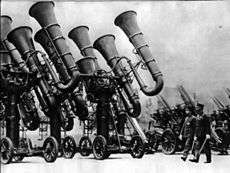War tuba

The Japanese war tuba (known in Japanese as: 九〇式大空中聴音機, "Type 90 large air sound detector") is a colloquial name sometimes applied to this Imperial Japanese Army acoustic locator due to the visual resemblance to the musical tuba. The name derived from a misidentification, possibly in jest, of a historical pre-World War II (1930s) photograph featuring Japanese Emperor Hirohito (posthumous name Shōwa) inspecting a trio of acoustic locators with a backdrop of anti-aircraft cannons.
Acoustic location
Acoustic location devices were used by military services from mid-World War I to the early years of World War II for the passive detection of approaching enemy aircraft by listening for the noise of their engines. These typically consisted of large acoustic horns attached to stethoscope-type earphones worn by monitors. This technology was rendered obsolete before and during World War II by the introduction of radar, which was far more effective. Some examples of parabolic concrete acoustic location mirrors can still be found on the seacoast of Britain to this day.